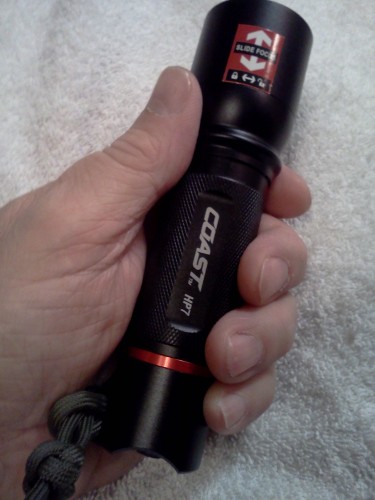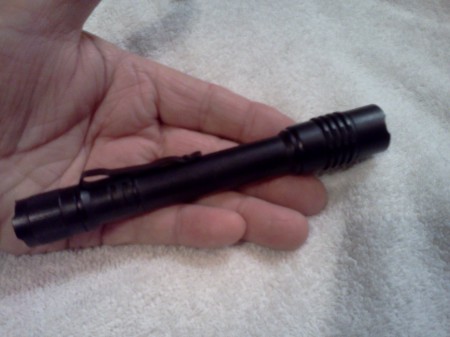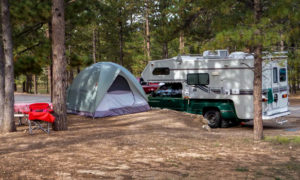

Everyone needs a flashlight sooner or later. Most everyone owns at least one. But I think RVers have more use for flashlights than the average person.
Don’t try to back into a campsite and set up camp at night without a flashlight. How about walking the dog, returning from the activities center or visiting the facilities at night? Even if it isn’t absolutely necessary, a good flashlight will make the walk a lot safer.
Before I continue on the topic of choosing an LED flashlight I need to say right off, I am no expert on the subject. What I am sharing with you here is information I have learned in my own search for the ‘perfect’, for me, LED flashlight. I offer it as accurate to the best of my knowledge. Please do your own research and evaluate any flashlights discussed in this article with your own budget and needs in mind.
I’ve categorized the uses for flashlights into 5 different uses/needs. High Lumen, Outdoor Use, Indoor Use, Pocket or Purse Carry and Keychain Carry.
These categories seemed natural to me but only serve as an aid for discussion.
These days, a given flashlight can serve in more than one category which can make choosing a flashlight confusing.
After quality, there are the three primary factors to consider when choosing an LED flashlight.
- Size
- Lumens
- Run Time
Generally speaking, you can choose only two of the above.
High lumens in a small flashlight will sacrifice run time. To have longer run time and high lumen output you’ll need larger batteries which means a larger flashlight. You get the idea. Keep this axiom in mind when you consider the amount of lumens you need or battery run time when buying your flashlight.
High Lumen
If you’ve ever tried to read a rural street sign or house address on a moonless night you’ll appreciate a high-lumen flashlight. There are any number of good reasons why YOU might want a high-lumen flashlight. But what is considered high lumen?
The low end of the high Llmen mode scale is 100 lumens.
My high lumen flashlight, rated at 250 lumens, is in the middle.

I consider a practical high to be about 400 lumens. Above that you begin to need more or larger batteries or sacrifice a reasonable runtime. Let me be clear, that is just my opinion. I’m sure others will argue for higher lumens and really there is no limit, 400 lumen flashlights are common.
My choice was a Coast HP7 High Performance Focusing 251 Lumen LED Flashlight. I can switch between a high output setting of 251 lumens for high power and a low output of 58 lumens. It also has a focusing bezel to switch between a spot beam and a flood beam.
The HP7 uses 4 AAA batteries has a 5 hour run time and a throw of 200 yards on high mode. On low mode run time is 10 hours and the throw is about 70 yards.
Outdoor Use
The low end for practical outdoor use is about 30 lumens but if you’re using a flashlight to walk the dog at night or make your way back to the rig from the activity center you may want more lumens to light your way. You may want a good spot beam that also has a wide flood beam for nightly walks. A larger bezel and reflector will usually provide a wider flood beam.
My Coast HP7 also serves as my outdoor light. For general use outdoors the low lumen mode is more than adequate for work around our 5th wheel and truck. It’s nice to be able to switch between spot and flood beams, depending on the job.
Indoor Use
Look for a flashlight with a minimum of 10 Lumens. The midrange would be about 30 lumens.
How bright your light needs to be depends if you just use it at night or in the daytime too. At night when your eyes are adjusted to the dark it takes very little light to see an 10 lumens would be more than enough.
If you use it during the day to see unto the back of a dark pantry or closet then you need a brighter flashlight to overcome the ambient light your eyes are adjusted to.

My indoor flashlight is a Streamlight ProTac 2AA . With 155 lumens in high mode it can serve fairly well as a high-power and outdoor flashlight too. For Indoor use the 11 lumen low mode is adequate and I always have the high-mode if I need more light.
Pocket or Purse Carry
I use my pocket flashlight more that any other flashlight I own simply because I nearly always have it with me. I use it outdoors, indoors, day and night. That means it needs to be versatile.
My pocket carry is the Fenix E11 Flashlight. It’s high mode is 105 lumens with a 1 hour 50 minutes runtime and the low mode is 32 lumens for 8 hours 30 minutes of run time. it has a rated throw of about 70 yards. It is small enough for me and uses one AA battery.

Of course size is the primary consideration when choosing a pocket carry flashlight. Generally, smaller is better but if it’s too small you’ll either sacrifice brightness or run time. If it is so big that it doesn’t feel comfortable in your pocket you won’t carry it.
For purse carry, size may be less of an issue but it is still something to be considered. A Fenix E11 would be good for a small purse while something similar to the StreamLight ProTac 2AA flashlight might work well and provide better overall service.
Keychain Carry
Because I have a pocket carry light a keychain light is just a backup. Even so, if I’m going to carry one I want it to be bright and reliable. Most important, for me, a keychain light needs to be small.
I’ve carried a keychain light several times in the past but was never really happy with them. They were not very bright and they all had a power switch on the side that could turn the light on while in my pocket.
Another issue I have with many keychain lights is the switch is intermittent. Meaning you have to keep pressing the switch to keep the light on. That could be a problem if you ever need a light and both hands at the same time.
I have chosen to carry a Streamlight 73001 Nano Miniature Keychain LED Flashlight
. It is rated at 10 lumens with 8 hours run time. It is as small as a practical light can be and about as bright as you could reasonably expect for a light it’s size. It certainly brighter that other keychain lights I’ve carried.

I’ve seen people with all kinds of bulky things attached to their keys so if size is not a big issue for you the Fenix E11 would make a good keychain light. But the AAA battery powered Fenix LD01 Flashlight is smaller and still very bright.
The Power Switch
Most LED flashlights these days are built with the switch at the end of the light… usually referred to as a tail switch.
You can find a few flashlights with a side switch.
Other flashlights imitate magLights by twisting the bezel to turn the light on and off. These often use the bezel to switch modes too.
I found out that side switches on pocket and keychain flashlights would turn on while in my pocket running down the battery so I switched to recessed tail switches for flashlights in those categories.
Tail switches come recessed and exposed. The exposed tail switches have the same problem for pocket and keychain lights as the side switches.
Modes
Except for the small flashlights like the StreamLight Nano keychain light and the cheap under $10 lights, most all LED flashlights have modes. The most common modes are high, middle and low brightness, strobe and S.O.S. Some lights have only one mode. Most have high and low brightness mode. Others have all of them.
Price
What should expect to pay for a good LED flashlight?
The old adage, you get what you pay for, applies to buying an LED flashlight but you can always pay more for a flashlight than it’s worth.
I’ve seen the same flashlight offered on ebay (Buy it Now) and Amazon at different prices, so it pays to shop.
Let me use my own lights to give you an idea of what you can expect to pay for a quality flashlight.
The Streamlight Nano I attached to my keychain cost me $8.
The price of the Fenix E11 I carry in my pocket was $27.
The StreamLight ProTac 2AA is my general use (indoor/outdoor) flashlight and cost $30.
A Coast HP7 serves as my High Power flashlight and cost me $43.
All were purchased on Amazon but are available elsewhere.
I think if you work in the $25 to $60 price range when shopping you are likely to get good value.
Brand
It’s not that name brand products are necessarily better than lesser known brands or generics, it is that you have more assurance the name brand product is a good product. Whereas you can spend a lot of money on cheaper non-name brand flashlights before you find a good one.
I’ve listed a few of the name brand flashlight companies along with some lesser known brands that have good reviews on Amazon and YouTube.
- 4Sevens
- Coast
- Coleman*
- Dorcy*
- Duracell*
- EagleTac
- Fenix
- Gerber*
- Jetbeam
- Lenser
- Maglight
(make sure it’s LED)
- Pelican
- Rayovac*
- Streamlight
- Surefire
* These are budget brands that offer some specific flashlights with good reviews. Not all of their flashlights are LEDs.
Conclusion
I hope I have given you enough information about LED flashlights that you can begin shopping for one, but there is much more to learn. Tank your time, don’t buy the first flashlight that looks good, read the product information for each light and compare.
I have linked to the flashlights mentioned in this article to Amazon.com. You can get more details about them and, more importantly, you can read reviews from owners and comapre similar flashlights.
I am an Amazon affiliate so I do make a very small commission on sales and it helps pay my website expenses.
Visit YouTube for reviews.
Chances are that someone has made a YouTube video review of the flashlight you are interested in. Watch a few before you make the decision to buy. Just enter the brand name and model into the YouTube search box and you’ll most likely you’ll find several reviews.
Hare are some videos to get you started.
Flashlight Philosophy – A great companion video to this article.
http://youtu.be/i7WdcYv57aQ
How To Find The Perfect Flashlight For You
http://youtu.be/Em7ThkwK-yI
Choosing the Right Flashlight
Want to ask the experts? For more information about flashlights visit:
http://www.candlepowerforums.com







I am a big advocate for the rechargeable flashlights myself. The Fenix brand is good. But if I was to only choose one it would have to be the Fenix TK22
I am slowly converting to rechargeable batteries but I will still be using the AA and AAA size batteries. The reason for standardizing on the AA and AAA batteries is that they are readily available.
The Fenix TK22 is fine flashlight but too expensive for my budget and too large compared to the Coast HP-7.